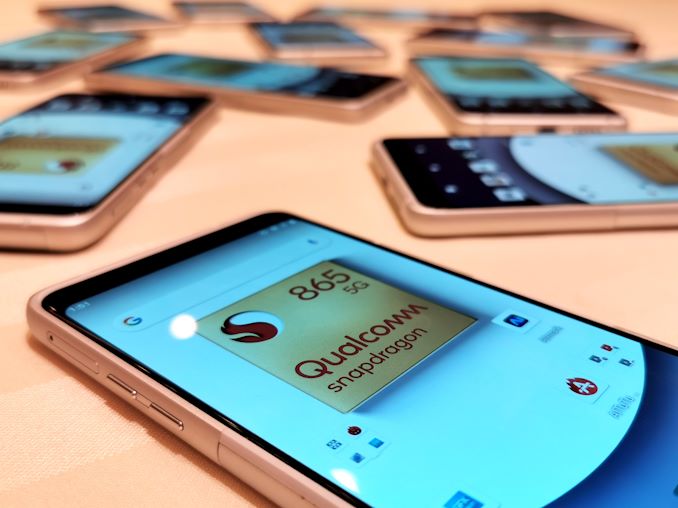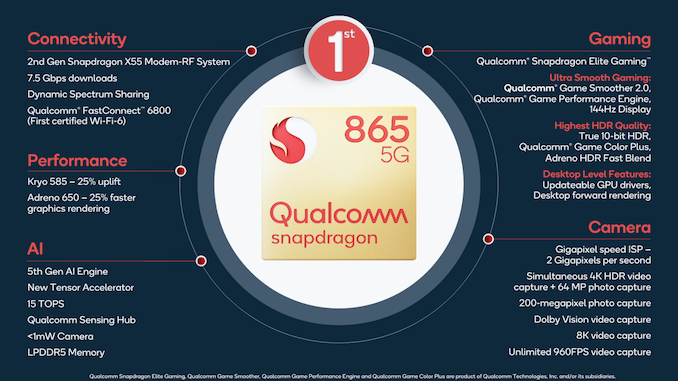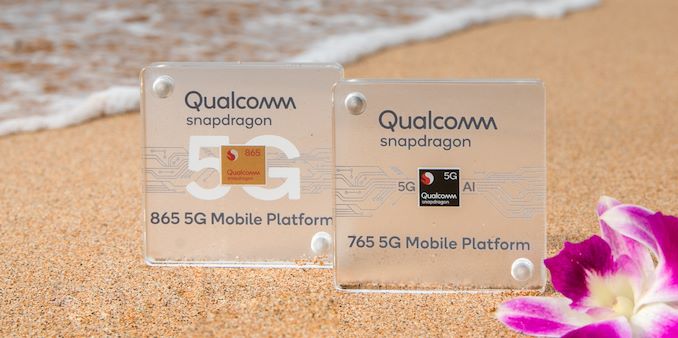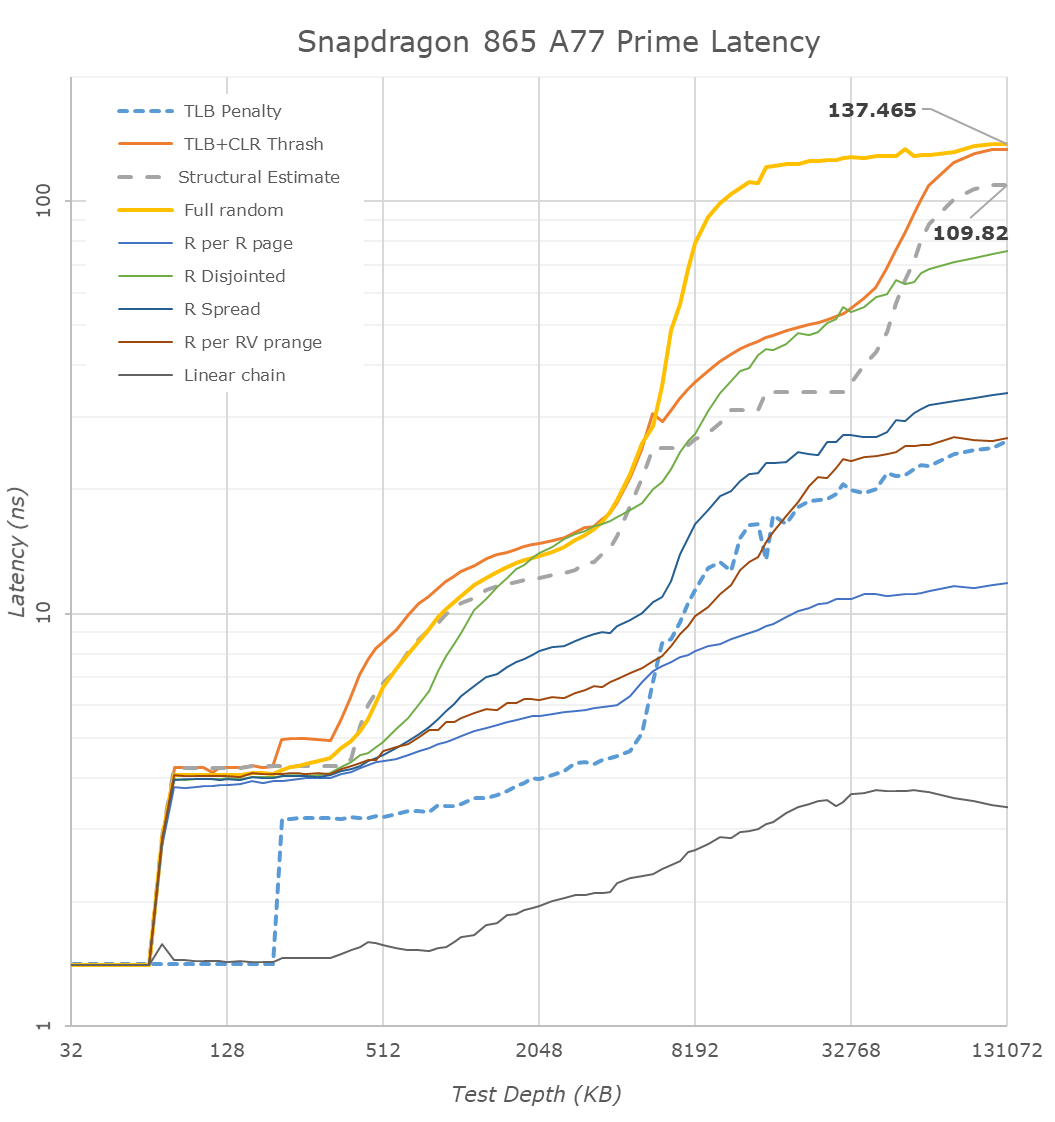The Snapdragon 865 Performance Preview: Setting the Stage for Flagship Android 2020
by Andrei Frumusanu on December 16, 2019 7:30 AM EST- Posted in
- Mobile
- Qualcomm
- Smartphones
- 5G
- Cortex A77
- Snapdragon 865

Earlier this month we had the pleasure to attend Qualcomm’s Maui launch event of the new Snapdragon 865 and 765 mobile platforms. The new chipsets promise to bring a lot of new upgrades in terms of performance and features, and undoubtedly will be the silicon upon which the vast majority of 2020 flagship devices will base their designs on. We’ve covered the new improvements and changes of the new chipset in our dedicated launch article, so be sure to read that piece if you’re not yet familiar with the Snapdragon 865.
As has seemingly become a tradition with Qualcomm, following the launch event we’ve been given the opportunity to have some hands-on time with the company’s reference devices, and had the chance to run the phones through our benchmark suite. The QRD865 is a reference phone made by Qualcomm and integrates the new flagship chip. The device offers insight into what we should be expecting from commercial devices in 2020, and today’s piece particularly focuses on the performance improvements of the new generation.
- Qualcomm Announces Snapdragon 865 and 765(G): 5G For All in 2020, All The Details
- Qualcomm Windows on Snapdragon: New 7c & 8c SoCs for sub-$800 Laptops
- Quick Bytes: Qualcomm’s Dynamic Spectrum Sharing Demo with 5G and 4G
- Quick Bytes: Qualcomm’s Prediction of 1.4 Billion 5G Smartphones by 2022
- Qualcomm Snapdragon Tech Summit Live Blog: Day One
- Qualcomm Snapdragon Tech Summit Live Blog Day Two: All About Mobile
- Qualcomm Snapdragon Tech Summit Day 3 Live Blog: ACPC and XR
A quick recap of the Snapdragon 865 if you haven’t read the more thorough examination of the changes:
| Qualcomm Snapdragon Flagship SoCs 2019-2020 | |||
| SoC |
Snapdragon 865 |
Snapdragon 855 | |
| CPU | 1x Cortex A77 @ 2.84GHz 1x512KB pL2 3x Cortex A77 @ 2.42GHz 3x256KB pL2 4x Cortex A55 @ 1.80GHz 4x128KB pL2 4MB sL3 @ ?MHz |
1x Kryo 485 Gold (A76 derivative) @ 2.84GHz 1x512KB pL2 3x Kryo 485 Gold (A76 derivative) @ 2.42GHz 3x256KB pL2 4x Kryo 485 Silver (A55 derivative) @ 1.80GHz 4x128KB pL2 2MB sL3 @ 1612MHz |
|
| GPU | Adreno 650 @ 587 MHz +25% perf +50% ALUs +50% pixel/clock +0% texels/clock |
Adreno 640 @ 585 MHz |
|
| DSP / NPU | Hexagon 698 15 TOPS AI (Total CPU+GPU+HVX+Tensor) |
Hexagon 690 7 TOPS AI (Total CPU+GPU+HVX+Tensor) |
|
| Memory Controller |
4x 16-bit CH @ 2133MHz LPDDR4X / 33.4GB/s or @ 2750MHz LPDDR5 / 44.0GB/s 3MB system level cache |
4x 16-bit CH @ 1866MHz LPDDR4X 29.9GB/s 3MB system level cache |
|
| ISP/Camera | Dual 14-bit Spectra 480 ISP 1x 200MP 64MP ZSL or 2x 25MP ZSL 4K video & 64MP burst capture |
Dual 14-bit Spectra 380 ISP 1x 192MP 1x 48MP ZSL or 2x 22MP ZSL |
|
| Encode/ Decode |
8K30 / 4K120 10-bit H.265 Dolby Vision, HDR10+, HDR10, HLG 720p960 infinite recording |
4K60 10-bit H.265 HDR10, HDR10+, HLG 720p480 |
|
| Integrated Modem | none (Paired with external X55 only) (LTE Category 24/22) DL = 2500 Mbps 7x20MHz CA, 1024-QAM UL = 316 Mbps 3x20MHz CA, 256-QAM (5G NR Sub-6 + mmWave) DL = 7000 Mbps UL = 3000 Mbps |
Snapdragon X24 LTE (Category 20) DL = 2000Mbps 7x20MHz CA, 256-QAM, 4x4 UL = 316Mbps 3x20MHz CA, 256-QAM |
|
| Mfc. Process | TSMC 7nm (N7P) |
TSMC 7nm (N7) |
|
The Snapdragon 865 is a successor to the Snapdragon 855 last year, and thus represents Qualcomm’s latest flagship chipset offering the newest IP and technologies. On the CPU side, Qualcomm has integrated Arm’s newest Cortex-A77 CPU cores, replacing the A76-based IP from last year. This year Qualcomm has decided against requesting any microarchitectural changes to the IP, so unlike the semi-custom Kryo 485 / A76-based CPUs which had some differing aspects to the design, the new A77 in the Snapdragon 865 represents the default IP configuration that Arm offers.
Clock frequencies and core cache configurations haven’t changed this year – there’s still a single “Prime” A77 CPU core with 512KB cache running at a higher 2.84GHz and three “Performance” or “Gold” cores with reduced 256KB caches at a lower 2.42GHz. The four little cores remain A55s, and also the same cache configuration as well as the 1.8GHz clock. The L3 cache of the CPU cluster has been doubled from 2 to 4MB. In general, Qualcomm’s advertised 25% performance uplift on the CPU side solely comes from the IPC increases of the new A77 cores.
The GPU this year features an updates Adreno 650 design which increases ALU and pixel rendering units by 50%. The end-result in terms of performance is a promised 25% upgrade – it’s likely that the company is running the new block at a lower frequency than what we’ve seen on the Snapdragon 855, although we won’t be able to confirm this until we have access to commercial devices early next year.
A big performance upgrade on the new chip is the quadrupling of the processing power of the new Tensor cores in the Hexagon 698. Qualcomm advertises 15 TOPS throughput for all computing blocks on the SoC and we estimate that the new Tensor cores roughly represent 10 TOPS out of that figure.
In general, the Snapdragon 865 promises to be a very versatile chip and comes with a lot of new improvements – particularly 5G connectivity and new camera capabilities are promised to be the key features of the new SoC. Today’s focus lies solely on the performance of the chip, so let’s move on to our first test results and analysis.
New Memory Controllers & LPDDR5: A Big Improvement
One of the larger changes in the SoC this generation was the integration of a new hybrid LPDDR5 and LPDDR4X memory controller. On the QRD865 device we’ve tested the chip was naturally equipped with the new LP5 standard. Qualcomm was actually downplaying the importance of LP5 itself: the new standard does bring higher memory speeds providing better bandwidth, however latency should be the same, and power efficiency benefits, while there, shouldn’t be overplayed. Nevertheless, Qualcomm did claim they focused more on improving their memory controllers, and this year we’re finally seeing the new chip address some of the weaknesses exhibited by the past two generations; memory latency.
We had criticised Qualcomm’s Snapdragon 845 and 855 for having quite bad memory latency – ever since the company had introduced their system level cache architecture to the designs, this aspect of the memory subsystem had seen some rather mediocre characteristics. There’s been a lot of arguments in regards to how much this actually affected performance, with Qualcomm themselves naturally downplaying the differences. Arm generally notes a 1% performance difference for each 5ns of latency to DRAM, if the differences are big, it can sum up to a noticeable difference.
Looking at the new Snapdragon 865, the first thing that pops up when comparing the two latency charts is the doubled L3 cache of the new chip. It’s to be noted that it does look that there’s still some sort of logical partitioning going on and 512KB of the cache may be dedicated to the little cores, as random-access latencies start going up at 1.5MB for the S855 and 3.5MB for the S865.
Further down in the deeper memory regions, we’re seeing some very big changes in latency. Qualcomm has been able to shave off around 35ns in the full random-access test, and we’re estimating that the structural latency of the chip now falls in at ~109ns – a 20ns improvements over its predecessor. While it’s a very good improvements in itself, it’s still a slightly behind the designs of HiSilicon, Apple and Samsung. So, while Qualcomm still is the last of the bunch in regards to its memory subsystem, it’s no longer trailing behind by such a large margin. Keep in mind the results of the Kirin 990 here as we go into more detailed analysis of memory-intensive workloads in SPEC on the next page.
Furthermore, what’s very interesting about Qualcomm’s results in the DRAM region is the behaviour of the TLB+CLR Trash test. This test is always hitting the same cache-line within a page across different, forcing a cache line replacement. The oddity here is that the Snapdragon 865 here behaves very differently to the 855, with the results showcasing a separate “step” in the results between 4MB and ~32MB. This result is more of an artefact of the test only hitting a single cache line per page rather than the chip actually having some sort of 32MB hidden cache. My theory is that Qualcomm has done some sort of optimisation to the cache-line replacement policy at the memory controller level, and instead the test hitting DRAM, it’s actually residing at on the SLC cache. It’s a very interesting result and so far, it’s the first and only chipset to exhibit such behaviour. If it’s indeed the SLC, the latency would fall in at around 25-35ns, with the non-uniform latency likely being a result of the four cache slices dedicated to the four memory controllers.
Overall, it looks like Qualcomm has made rather big changes to the memory subsystem this year, and we’re looking forward to see the impact on performance.













178 Comments
View All Comments
michael2k - Wednesday, December 18, 2019 - link
I know you want to think that, but the 855 right now barely competes with the A13. The gap may be getting smaller, but when Apple has a multiple year lead in performance, it will take multiple years of iteration to catch up, and that assumes Apple isn't growing either.From the article, the 865 wasn't very competitive with the older A12:
On the integer side, the A77 still trails Apple’s Monsoon cores in the A11, but the new Arm design now has been able to trounce it in the FP suite. We’re still a bit far away from the microarchitectures catching up to Apple’s latest designs, but if Arm keeps up this 25-30% yearly improvement rate, we should be getting there in a few more iterations.
...
The QRD865 really didn’t manage to differentiate itself from the rest of the Android pack even though it was supposed to be roughly 20-25% ahead in theory. I’m not sure what the limitation here is, but the 5-10% increases are well below what we had hoped for. For now, it seems like the performance gap to Apple’s chips remains significant.
...
There’s one apparent issue here when looking at the chart rankings; although there’s an improvement in the peak performance, the end result is that the QRD865 still isn’t able to reach the sustained performance of Apple’s latest A13 phones.
...
Looking at the estimated power draw of the phone, it indeed does look like Qualcomm has been able to sustain the same power levels as the S855, but the improvements in performance and efficiency here aren’t enough to catch up to either the A12 or A13, with Apple being both ahead in terms of performance, power and efficiency.
The 855 was released early this year and was not very competitive with the slightly older A11:
https://www.anandtech.com/show/14031/samsung-galax...
Deboo - Monday, January 27, 2020 - link
Isn't apple cpu cores are arm basedmichael2k - Tuesday, December 17, 2019 - link
The formal term for it is induction.Apple's GPU is very competitive in phones, sometimes taking the top spot, sometimes not:
https://www.anandtech.com/show/13392/the-iphone-xs...
But for their tablets, Apple proceeds to beef up the GPU over 2x the iPhone, in this case by having 75% more CPU cores, much better thermal capacity, and higher clockspeed:
https://www.anandtech.com/show/13661/the-2018-appl...
It is beaten by the GTX 1060, but beats the Ryzen 7, in PC space, and soundly beats the iPhone by 80% when not CPU bound.
So the inductive part is that, given the 865 approaches the performance of an iPhone, it won't approach the performance of an iPad.
id4andrei - Tuesday, December 17, 2019 - link
One thing to remember when you compare GPUs. Benchmarks usually run half precision operations on mobile compared to what they run on desktop - FP16 vs FP32. Also on ios they run Metal while on Windows DX12 or Vulkan or OpenGL. Not the same thing.IUU - Thursday, December 26, 2019 - link
Apple cores beating the ryzen 7 is a very big word and requires a big leap of faithph00ny - Monday, December 16, 2019 - link
Probably. Android tablet is pretty dead and there is no real solid demand for a "faster" hardwaregeneralako - Monday, December 16, 2019 - link
That's a stupid exaggeration. If it were dead how come Huawei just released the Mediapad M6 this summer with Kirin 980, and is currently releasing an even more premium tablet right now? How come Samsung makes a new Tab S every year, along with iterations of cheaper models every now and then? Same with Xiaomi, Lenovo and others. Low-end market is sprawling with new tablets from all sorts of brands. Even LG released a tablet this year. The tablet market may not be huge, and certainly lackluster in a lot of ways on Android (mainly due to Google neglecting it since Nexus 9 was a flop; you don’t follow-up Nexus 7 v2—the best tablet ever made—with that nonsense), but it very much exists and is desired by a lot of customers. This reality is true for Apple too, that waited 4-5 years before it released a new iPad Mini iteration.As an avid tablet user myself, even with a lot to be desired on Android, I still very much like many offerings by them the past 2 years. I'm currently using both an iPad Mini 5 and Mediapad M6 8.4”. Seeing as I, like most other people, use tablett for media consumption (YouTube, streaming movies/shows, reading books, Reddit, browsing, Spotify), the available supported apps are equally good for both platforms. If I were to dive deeper to dedicated application, sure, iPad has much better support, I really never do as I use a tablet for the specific uses it was made for. I can see this be a complaint if you're an iPad Pro user and use it for professional work, but I don't really see that being a desire for even those using regular iPad or iPad Mini. Maybe if you’re a gamer, but that’s really it.
I use the Huawei more than the iPad Mini due to how much more intuitive Android is. At the end of the day, they both run oversized variants of their smartphone OS, and Android is simply more intuitive in a lot of respects, with iOS use still feeling like having one hand behind my back. Where Apple is fantastic though, is in its hardware implementation, like its excellent screen calibration and touch latency, or having a 3.5mm input (unlike M6 or newer Tab S, sadly) with really good DAC that properly drives my HD650. Mediapad wins in more effective and ease-of-use OS, 16:10 aspect ratio. Android also makes it easier to do things like torrenting (which is great for downloading/streaming movies, football matches, etc.), local file management and sharing and more. Ironically, Apple has made up for the Mediapad’s lack of jack with its fantastic 3.5mm Type-C for $7, which beats DACs upwards of 10x its price (no joke – Apple really knocked it out of the park).
imaheadcase - Tuesday, December 17, 2019 - link
Let alone the thousands of Samsung tablets with android that sell like hot cakes. Given the sell over holidays on them, they are even more attractive.Sure Samsung is terrible at updating software, but not a deal breaker by any means, i tried parents Ipad and it just felt wrong using it, i can't quite put finger on reason, just seems so limited with apps and just not responsive.
Things just work great on Android variant for me.
Oliseo - Thursday, December 19, 2019 - link
One look at Android App Stores tells you just how successful Android Tablets are. That's something everyone can do, and not just take some random fanboys drivel on a forum./end debate
Lois - Friday, December 27, 2019 - link
This is just your feeling and not a fact… Some people feel better on iPadOS and some others on Android. Now the fact is that iPad is more powerfull than andoid Tablets…